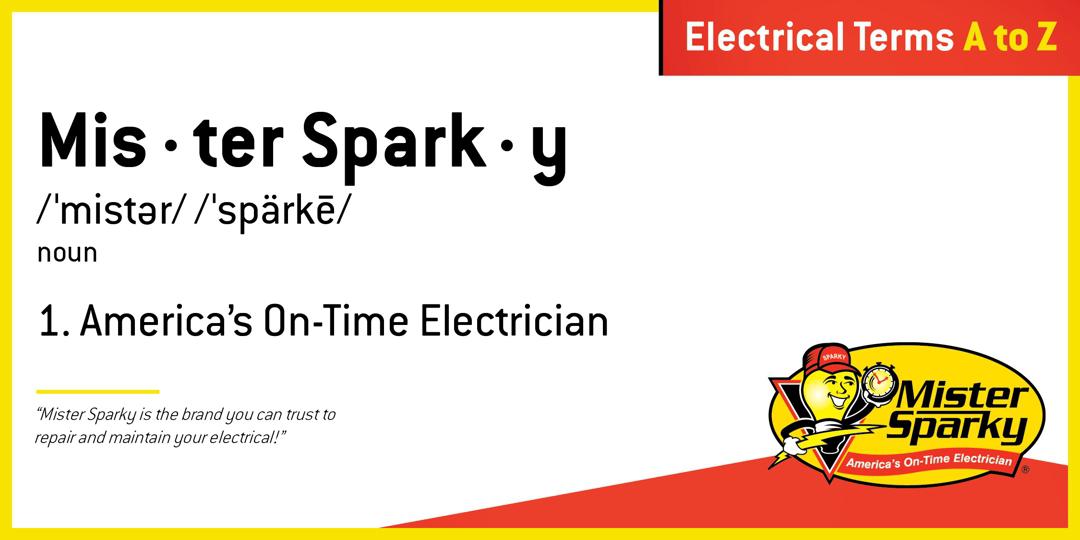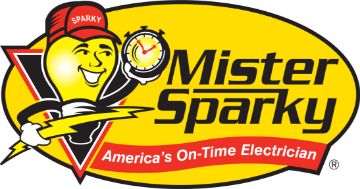50 Need to Know Electrical Terms to Help You Talk to An Electrician

Electrical work is serious business. That’s why it’s important to find a company that you can trust to take care of the electrical needs of your home, with you and your family’s safety as a priority. There are so many parts that go into making your home run and just as many electrical terms. It can be confusing!
We put together the top 50 must-know electrical terminologies that will help you talk to your electrician about what’s going wrong. These terms can also help you in the long run when your technician is explaining what the problem might be and how they can fix it.
A to Z Glossary of Electrical Terminology:
- AFCI – Arc Fault Circuit Interrupter: AFCI (Arc Fault Circuit Interrupter) breakers protect against electrical discharge in cords or wiring that can result in fire. These breakers immediately disconnect the damaged circuit before the arc builds up enough heat to catch fire.
- Ammeter: An instrument for measuring either direct or alternating electric current, in amperes.
- Ampere (Amp): The base unit of electric current
- Arc: An electric arc is a continuous discharge. (Whereas an electric spark discharge is momentary.) Arcing occurs when a circuit becomes overloaded, which can cause damage to the circuit breaker.
- Bonded: To electrically connect all exposed metal items (not designed to carry electricity in a room or building) as protection from electric shock.
- Circuit Breaker: A circuit breaker is an automatically operated electrical switch designed to protect an electrical circuit from damage caused by excess current from an overload or short circuit. A good circuit breaker protects you from power surges, interruption of power, and electrical fires.
- Conductor: An electrical conductor conducts electricity. The ability to conduct electricity is called electrical conductivity. A good electrical conductor has high conductivity and low resistivity. Resistivity is the reciprocal/opposite of conductivity. The following are a few examples of electrical conductors: Copper, Aluminum, Gold, Silver, Water, Human Skin.
- Conduit: A pipe, tube, or tile for protecting electric wires or cables.
- Copper: Copper is the electrical conductor in many categories of electrical wiring, used in power generation, transmission, and distribution, telecommunications (like 5G), as well as electrical equipment.
- Direct Burial: Direct-burial cable can be run inside a conduit to add additional protection to any electrical system. This type of cable is designed to withstand direct exposure to the soil and moisture and is rated for wet, dry, and damp environments.
- Electrical Panel/Box: A hub that connects a power source to the home; distributes electrical currents to different circuits in the home. Typically, a panel/box is a metal box with a door built into a wall.
- Feeder: Feeders are power lines through which electricity is transmitted in power systems.
- Flex: Flex connects appliances and lights to fixed wiring. For example, flexible conduits are used to connect to motors or other devices where isolation from vibration is useful, or where an excessive number of fittings would be needed to use rigid connections.
- Fuse: An electrical safety device that protects a circuit from excess current or overcurrent. Overcurrent can lead to too much heat being generated, which can cause fire or damage.
- Generator: Generators are standby devices that can supply electricity to your home during power outages. During a power outage, it allows you to continue to operate essential appliances such as refrigerators, computers, heating and cooling systems, and lighting. Home generators can be either portable or stationary. The main differences between stationary and portable models are in their connection and activation. A portable unit has to be moved to your location, filled with fuel and then connected to the fuel line, manually started then connected to your load requirement. Portable units allow for easy storage when needed. A stationary unit can start immediately and is usually already wired to the home and the fuel source. When choosing which type of generator, consider how much space you have for the unit; a stationary unit may require a concrete pad.
- GFCI – Ground Fault Circuit Interrupter: Ground fault circuit interrupters work by constantly monitoring the amount of current running through a circuit and cut power to the circuit when tripped by an overload. The instant that the current level returning from the circuit drops below the level going out – which could indicate that the electricity is escaping to the ground, possibly through a human – the GFCI trips and cuts off the power.
- Ground/Grounding/Grounded: To "ground" electricity refers to the effective and safe way to route electricity back to the ground. This means that excess (and potentially dangerous) electricity has somewhere to go. (And not through a person!)
- Hot: A hot wire is receiving power, or active.
- Kilowatts: A kilowatt (kW) measures power, the rate at which something uses energy. A kilowatt-hour (kWh) measures energy, which is the capacity to do work.
- LED Lighting: LED stands for Light Emitting Diodes. LED lights are up to 90% more efficient than standard incandescent bulbs, producing more light for longer periods.
- Meter (electrical): A device that measures the amount of electricity used. A multimeter is a measuring instrument that can measure multiple electrical properties.
- NEC – National Electrical Code: The NEC is published by the National Fire Protection Association (NFPA), and provides guidelines and requirements for electrical safety, plus the standards for the safe installation of electrical in the U.S.
- NM (non-metallic) Cable: Also referred to as Romex (a popular brand), is a flexible electrical cable, featuring outer plastic designed to project insulated conductors.
- Ohms: A unit of electrical resistance, expressing the resistance in a circuit transmitting a current of one ampere when subjected to a potential difference of one volt. One way to think of ohms is as water flowing through a pipe. The voltage is the water pressure, the current is the amount of water flowing through the pipe, and the resistance (ohms) is the size of the pipe. More water will flow through the pipe (current) the more pressure is applied (voltage) and the bigger the pipe is (lower the resistance).
- Outlet: An electrical outlet also referred to as a socket, plug, or wall plug, connects an electrical device (like a hairdryer or TV) to an electricity supply.
- Outlet Plate or Cover: A protective covering for light switches or electrical outlets, which protects the electrical hardware.
- Parallel Short: A short occurs when one branch of a double circuit develops a short, allowing high currents to flow through the other branch.
- Receptacle: Refers to a type of electrical outlet or socket, namely a wall plug, that provides a location where electrical current can be accessed as a power source.
- Resistance: Expressed in ohms, it is a measure of how difficult it is for an electric current to pass through a substance.
- Riser: Electrical risers are special conduits that go vertically for power, telephone, communications, fiber, etc. They and the wires within must be specially designed to prevent fires from climbing the wires and spreading to other floors.
- Series Circuit: Refers to the same amount of current flowing through each element of a circuit.
- Short Circuit: A malfunctioning connection between two nodes of an electrical circuit that allows a current to travel along an unintended path with no or very low electrical impedance. This results in an excessive current flowing through the circuit.
- Single and Double Pole Breaker: Single-pole breakers control standard lighting and outlets and are rated at 120 volts and 15,020 amps. Double-pole breakers are rated higher at 240 volts, 20-60 amps. They supply power to larger appliances like clothes dryers and oven ranges.
- Single Phase: Single-phase power is a two-wire alternating current (AC) power circuit. Typically, there is one power wire—the phase wire—and one neutral wire, with current flowing between the power wire (through the load) and the neutral wire.
- Single pole switch: A switch that has one input and one output - on and off.
- Splice: The "joint" of two joined electric wires.
- Strut: A support tool or fitting is used to support electrical equipment like panels and cable boxes.
- Subpanel: A smaller, complimentary panel that distributes power to a specific area of the home. Often known as a circuit breaker box.
- Surge Protection: An appliance or device that protects electrical units from voltage spikes, which can lead to dangerous overloads and fires.
- Three Phase: Three-phase power is a three-wire AC power circuit with each phase ac signal 120 electrical degrees apart.
- Three-way switch: Multiple location points to access power. For example, having more than one switch to control one light.
- Transfer Switch (ATS/MTS): A device that transfers power from its original source (like a power line). An ATS (or Automatic Transfer Switch) is connected to two sources of power. If one source fails, power from a backup source, like a generator, will kick in. An MTS (or Manual Transfer Switch) is used to manually change power sources if one fails. For example, if the power goes out, simply flip the MTS to switch to generator power.
- Traveler: A wire that carries voltage through a multi-way switch as in between two three-way switches. This offers two potential pathways to complete the circuit.
- Underground: Electrical circuits that are located beneath the ground, rather than above as in power lines. This is often a safer (protecting from elements like snow and ice) and aesthetically pleasing option.
- Voltage/Volts: Voltage is the ratio of two volts. A volt is a unit that refers to electrical potential, force, and difference.
- Wattage: A measurement of electrical operating power (such as in lamps or appliances).
- Weatherhead: A protective cap that defends electrical wires from the point of contact between entry into the building from an overhead (like power lines) or underground power sources.
- Wire (Hot, Neutral and Ground): Refers to three conductors within NM cables: Hot, Neutral, and Grounded. Read HERE to learn more.
- Wiring: An electrical installation of cabling and associated devices such as switches, distribution boards, sockets, and light fittings in a structure.
*Sourced from Mister Sparky electricians, Wikipedia, Merriam-Webster, The Spruce, and Britannia |
These are just a few terms regarding electrical properties and service work out there. At Mister Sparky, we are here to walk you through what the issue is, what we’re going to do to fix it, and address all the different components on what we’re doing. You will never be left in the dark – literally or figuratively!
Contact your local Mister Sparky today to book an appointment today!
